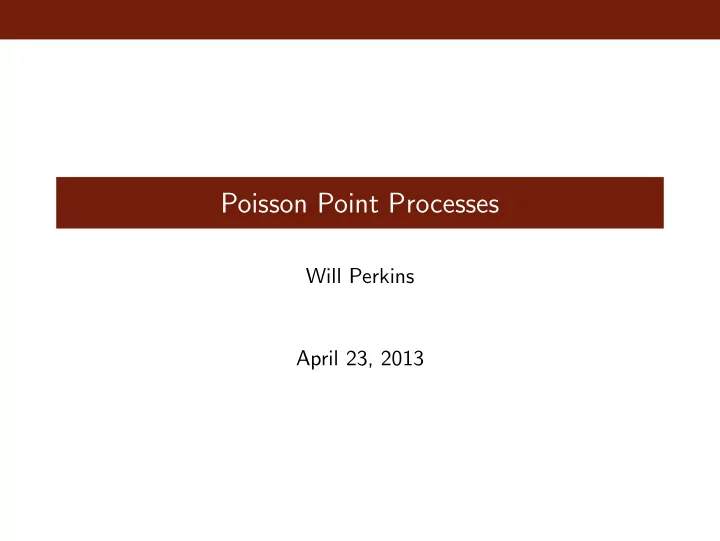

Poisson Point Processes Will Perkins April 23, 2013
The Poisson Process Say you run a website or a bank. How woul you model the arrival of customers to your site? Continuous time process, integer valued. What properties should the process have?
Properties 1 The numbers of customers arriving in disjoint time intervals are independent. 2 The number of customers arriving in [ t 1 , t 2 ] depends only on t 2 − t 1 . (Can be relaxed) 3 The probability that one customer arrives in [ t , t + ǫ ] is ǫλ + o ( ǫ ). 4 The probability that at least two customers arrive in [ t , t + ǫ ] is o ( ǫ ).
The Poisson Process Theorem If a process N ( t 1 , t 2 ) satisfies the above properties, then N (0 , t ) has a Poisson distribution with mean λ t. Such a process is called a Poisson process. Proof:
Other Properties 1 Conditioning on the number of arrivals in [0 , T ], how are the arrival times distributed? 2 What is the distribution of the time between arrival k and k + 1? 3 Does this process have the continuous-time Markov property? Proofs:
Constructing a Poisson Process We can construct a Poisson process using a sequence of iid random variables. Let X 1 , X 2 , . . . be iid Exponential rv’s with mean 1 /λ . Then let k +1 � N (0 , t ) = inf { k : X i ≥ t i =1 Show that this is a Poisson process with mean λ . What would happend if we chose a different distribution for the X i ’s?
Inhomogeneous Poisson Process Let f ( t ) be a non-negative, integrable function. Then we can define an inhomogeneous Poisson process with intensity measure f ( t ) as follows: 1 The number of arrivals in disjoint intervals are independent. 2 The number of arrivals in [ t 1 , t 2 ] has a Poisson distribution � t 2 with mean µ = t 1 f ( t ) dt .
Spatial Poisson Process We can think of the Poisson process as a random measure on R . This is an infinite point measure, but assigns finite measure to any bounded subset of R . Can we generalize to R 2 or R 3 ?
Spatial Poisson Process Define a random measure µ on R d (with the Borel σ -field) with the following properties: 1 If A ∩ B = ∅ , then µ ( A ) and µ ( B ) are independent. 2 µ ( A ) has a Poisson distribution with mean λ m ( A ) where m ( A ) is the Lebesgue measure (area). This is a spatial Poisson process with intensity λ . Similarly, we can define an inhomogeneous spatial Poisson process with intensity measure f : R d → [0 , ∞ ).
Spatial Poisson Process Exercise 1: Show that the union of two independent Poisson point processes is itself a Poisson point process. Exercise 2: Take a Poisson point process on R d and then independently color each point red with probability p and green otherwise. Show that the red points and the green points form independent Poisson point processes. Exercise 3: Conditioned on the number of points in a set A , find the distribution of the positions of the points in A .
Recommend
More recommend